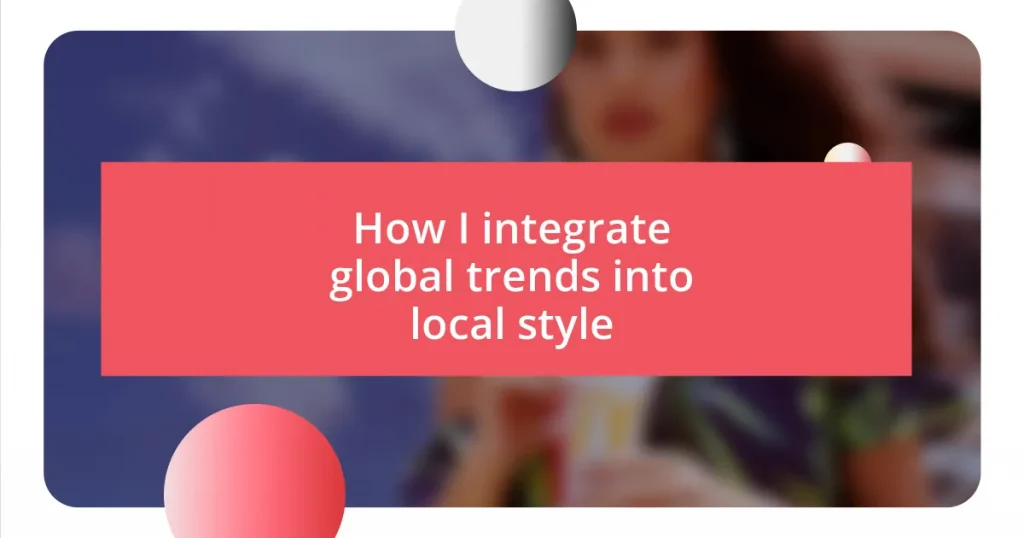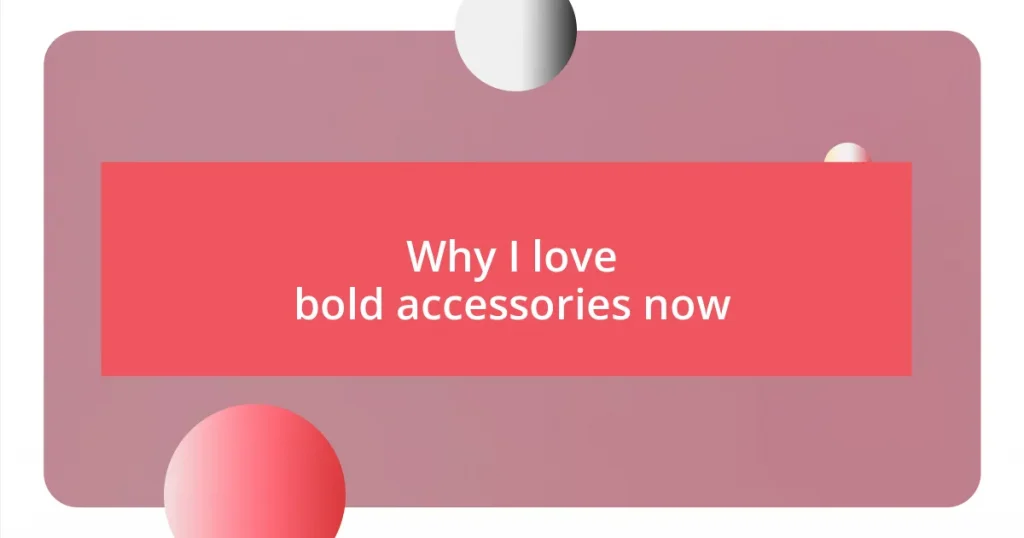Key takeaways:
- Global fashion trends are influenced by cultural dynamics, with sustainability becoming a key global principle.
- Local cultural influences, such as traditional attire and local art, enhance the interpretation of global trends.
- Understanding consumer preferences, particularly regarding sustainability, is crucial for aligning market demands with fashion choices.
- Promoting a fashion line successfully requires storytelling, effective use of social media, and collaboration with local influencers.

Understanding global fashion trends
Understanding global fashion trends is all about recognizing the cultural influences that shape them. For instance, I remember my trip to Paris, where I noticed how street style was a bold mix of high fashion and casual wear. It struck me how different cultures interpret creativity and individual expression through clothing.
As I delve into fashion weeks around the world, I often find myself questioning: What makes a trend resonate globally? Take sustainability as an example; it started in niche markets but quickly became a defining principle across continents. It’s a reminder that as consumers, we are increasingly aware of our impact, and brands are responding in remarkable ways.
I’ve also observed that certain trends ebb and flow, often influenced by historical events or shifts in societal norms. For instance, the resurgence of 90s fashion feels deeply nostalgic for me, sparking memories of my youth. It’s fascinating how cycles repeat, reflecting not just style but the rhythm of our lives. Understanding these dynamics can help us connect our local styles to the greater global conversation.

Identifying local cultural influences
Identifying local cultural influences is essential when merging global trends with local style. I often find myself wandering through local markets, where the vibrant textiles and traditional crafts tell stories of the community’s history. The intricate patterns and colors not only celebrate local heritage but also resonate with global aesthetics, making it clear how these influences intertwine.
In my experience, family traditions often shape personal style, particularly during festivals or cultural events. I remember attending a wedding in my hometown, where guests embraced traditional attire infused with contemporary flair. This blend highlighted how cultural influences evolve, adapting to modern trends while retaining their essence. It’s a beautiful testament to how local culture can enhance and inform global fashion narratives.
Additionally, I pay close attention to local art and music scenes, as they frequently inspire style choices in the community. For example, discovering a local artist whose work celebrated folk imagery deeply impacted my wardrobe. I began incorporating those motifs, creating a dialogue between my style and our cultural narratives. What I’ve learned is that identifying these influences allows for a richer, more personalized approach to fashion, creating an authentic expression of oneself.
| Local Influences | Global Trends |
|---|---|
| Traditional textiles | Contemporary streetwear |
| Family heritage | Fashion cycles |
| Local art | Global aesthetics |

Evaluating market demands and preferences
In evaluating market demands and preferences, I’ve learned that understanding what resonates with consumers is key. During a recent visit to a local fashion event, I observed how attendees favored sustainable materials, reflecting a shift toward environmentally conscious choices. It was heartening to see the genuine excitement for brands championing eco-friendly practices, reinforcing my belief that consumer awareness drives significant changes in the industry.
- Consumers now prioritize sustainability in their purchasing decisions.
- Events like fashion fairs provide insight into emerging trends and preferences.
- Engaging directly with customers can reveal their thoughts on local versus global styles.
- Personal stories shared during interactions can highlight the emotional connections people have with fashion and culture.
In my experiences, I’ve found that social media plays a powerful role in shaping local preferences. I often scroll through feeds filled with influencers highlighting unique pieces, sparking local interest in global trends. One afternoon, I decided to host a small gathering to discuss fashion preferences with friends, and it turned into an eye-opening discussion on how we select clothing that tells our individual stories while still aligning with global movements. The variety of opinions really showcased the delicate balance between being inspired and staying authentic.

Implementing sustainable fashion practices
Implementing sustainable fashion practices has become a part of my lifestyle, and I truly believe it enhances my personal style. One day, I decided to transform an old pair of jeans into a trendy tote bag, which became a conversation starter at a recent gathering. I find joy in sharing how that small change reflects my commitment to reducing waste while still showcasing creativity. Have you ever thought about how your old clothes could be reimagined?
I’ve also made it a point to support local artisans who prioritize eco-friendly materials. Visiting a small craft fair last summer, I stumbled upon a booth selling handbags made from recycled fabric. I bought one and, every time I carry it, I feel a connection to the maker’s story and the sustainable practices they uphold. This experience reinforced my belief that embracing sustainable fashion not only feels good but also connects me to my community.
Moreover, I’ve started to participate in clothing swaps with friends, which has turned into a fun tradition. By exchanging garments, we share not just clothes but also our journeys and the significance those pieces hold in our lives. I wonder how many forgotten treasures are waiting to be rediscovered in your own wardrobe. This practice fosters creativity and minimizes our impact on the environment, proving that fashion can be both responsible and expressive.

Promoting your integrated fashion line
Promoting an integrated fashion line requires a unique blend of storytelling and authenticity. I remember when I launched my first collection; I hosted a pop-up shop that showcased not only the garments but also the stories behind them. Each piece was tied to a global trend while honoring local traditions, and seeing people connect with those narratives made the effort worthwhile. Have you ever noticed how a great story can transform a simple item into a coveted treasure?
Utilizing social media effectively can also amplify your promotional efforts. One evening, I shared a behind-the-scenes video of my design process, focusing on how I merge global inspirations with local culture. The enthusiasm in the comments was palpable; people loved the idea of wearing something that wasn’t just stylish but carried a story of connection. I realized that showcasing the journey of your products can evoke emotions and build a loyal community around your fashion line.
Lastly, collaborating with local influencers who share your values can significantly boost your visibility. A couple of months ago, I partnered with a local stylist who understood the essence of my brand. Together, we created an Instagram campaign highlighting the versatility of my pieces in everyday settings, further promoting the message of integration. Seeing my designs on someone who was genuinely excited about them reminded me how crucial it is to find ambassadors who reflect the spirit of your work. Have you ever thought about how collaboration can elevate your brand beyond what you could achieve alone?















